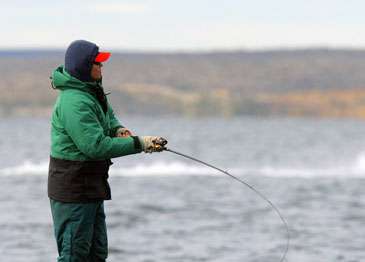
Now that we're well into fall, a lot of the bass that were shallow and chasing bait a month ago are now more dispersed. They're still chasing baitfish, but since the baitfish are more spread out, so are the bass. That's the bad news. The good news is that you can still find small concentrations of fall bass in the shallows (if you know where to look) and the average fish is going to be bigger than the ones we were catching last month.
This is a great time to tie on a Strike King Red Eye Shad and get cranking. The key to finding and catching these shallow fall bass is to cover lots of water, and a lipless crankbait is a great tool to do just that.
My go-to bait now is the 1/2-ounce Red Eye Shad in chrome Sexy Shad. It's a great baitfish imitator in clear water, but if the water's stained or cloudy, I'll use the old standby, Sexy Shad.
The key to this pattern is the presence of baitfish. They might be in the backs of pockets or on secondary points; they could even be on main lake points. Sometimes you'll be able to see them swimming or flitting on the surface, but you might also find them by pulling your lure through them and seeing them scatter. Either way, you'll want to pay close attention to their size and match it as closely as possible with your lure.
The 1/2-ounce Red Eye Shad is just right a lot of the time, but if the bait's smaller than that, drop down to the 1/4-ounce model.
My three favorite places to fish the Red Eye Shad at this time of year are around boat docks, submerged grass and rocks. You're usually going to find bass around that type of cover in the fall.
When fishing grass, I like to make a long cast and use a lift and drop retrieve that keeps the bait just above the cover. The Red Eye Shad has a terrific shimmying action when it falls, and I get lots of strikes then. You want the bait to fall to the top of the grass before you lift it up again. Be sure to let it fall on a semi-slack line so the lure has plenty of action. If the bait gets into the grass on the fall, just rip it free. You'll get a lot of strikes just as it pulls loose.
If the lift-and-drop retrieve doesn't work, try a straight retrieve. You have to experiment to find out just what the bass want on a particular day.
While grass is great for this pattern, docks and rocks can be good, too. Riprap and retaining walls are excellent targets for your Red Eye Shad. The algae that collects on these rocks and concrete really seems to attract baitfish, and, of course, that draws in the bass.
When you're fishing boat docks, be sure to get your crankbaits as close to the pilings as you can. They'll usually deflect right off when you bump them, and that can get you a lot of reaction strikes. It's also good if you can get the Red Eye Shad up underneath the dock. Those bass may see some lures, but they're not often lipless crankbaits.
For this crankbait pattern, I like to use an Ardent XS1000 with a 6.3:1 gear ratio. It's a great casting reel that picks up a lot of line with each crank.
My favorite line is Sunline Shooter Fluorocarbon in 16- to 20-pound test. Occasionally, I might drop down to 14-pound line if the water's really clear, the cover's very sparse or I need to make an extra long cast.
The rod I use depends upon the cover I'm fishing. Around grass, I like the St. Croix Legend Tournament Spinnerbait Sweeper. It's a 7-foot rod with a medium-heavy action that works great when you have to rip the grass off your bait.
Around rocks and docks, I like the 7-foot St. Croix Premier Glass rod. It's got a softer action that helps me keep fish on the hook and get them to the boat.
This is a great technique for catching lots of fall bass, and, as the water continues to cool, you'll find that the quality of the bass you're catching gets better and better.
Give this pattern a try the next time you're on the water. It'll work for you, too.





